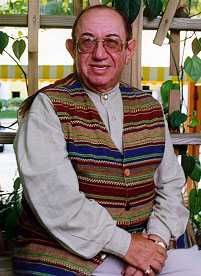

| Home | Daniel Keyes | "Flowers for Algernon" (the Short Story) |
Flowers for Algernon (the Novel) |
Charly (the film) |
Resources |
|---|

"The idea for Flowers for Algernon came to me many years before I wrote the story or the novel. 'What would happen if it were possible to increase human intelligence artificially?' The idea for the character came about four years later when I met and spoke to a retarded young man and thought how wonderful it would be if such a technique were available to help the mentally disadvantaged. But Charlie Gordon is not real, nor is he based on a real person: he is imagined or invented, probably a composite of many people I know -- including a little bit of me. After a great many false starts, I discovered the technique of the Progress Reports. With these three elements: the idea, the character, and the narrative strategy, I was well on my way."
--Daniel Keyes
Keyes developed the idea, story, character, and style for "Flowers for Algernon" over a fourteen-year period. In 1945 he was having issues with his parents pushing him to fulfill a pre-medical education. His "education [was] driving a wedge between [him] and the people [he] loved" (Keyes). He wanted to write, not be a pre-med student at NYU. He then had the idea of "artificially increasing human intelligence" on the subway. He then had a story line and a few passages written out, but was still missing the protagonist. He fiddled with different types of characters, but none fit just right. He wanted a character "who would be memorable and with whom the reader and I could identify; someone with a strong motivation and goal who evoked a response from other characters; someone whose inner life gave him a human dimension" (Keyes).
In 1957, after receiving his Masters in American Literature and his New York English teaching license, he taught English at his old high school. He taught two Modified English classes for lower I.Q. students. There was one boy who told him "I know this is a dummy class, and I wanted to ask you. If I try hard and I get smart by the end of the term, will you put me in a regular class? I want to be smart" (Keyes). He started writing stories around the idea of the gifted and the slow, comparing the two types of students.
It was not until 1958 when H. L. Gold called wanting Keyes to write a second story for Galaxy that he finally put his idea together with the character. "Recalling Aristotle's dictum in his Poetics, that a tragedy can happen only to the highborn, because there can be a tragic fall only from a great height, I thought, let's test that. What if someone the world views as the lowest of the low, a mentally handicapped young man, climbs to the peak of Book Mountain, the heights of genius? And then loses it all. I felt myself choking up as I thought about it" (Keyes).
Aurea, Keyes's wife, was working for the Larry Gordon Studio at the time, and her last boyfriend and Keyes's rival's name was Charlie. He decided to have the mouse "forecast events connected with the experiment" and named the mouse after Algernon Swinburne because he thought the name was unusual (Keyes). In addition, Keyes modeled Strauss and Nemur from his old psychiatrist and professors he encountered in graduate school.
Keyes did not publish with Galaxy because Gold wanted Charlie's operation to be permanent, making the ending happier. Instead, Keyes published with The Magazine of Fantasy and Science Fiction in 1959 after cutting out 10,000 words.
Summary of:
"Algernon, Charlie, and I: A Writer's Journey"
by Daniel Keyes
Fantasy and Science Fiction, 2000